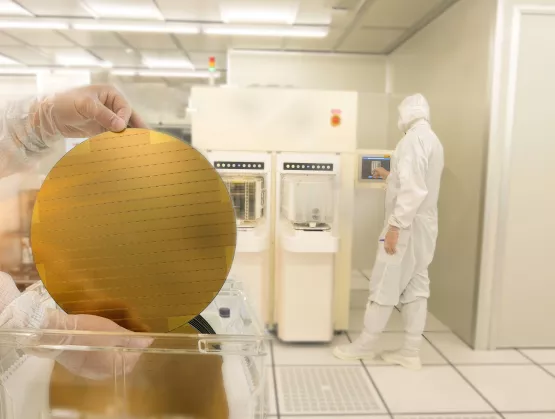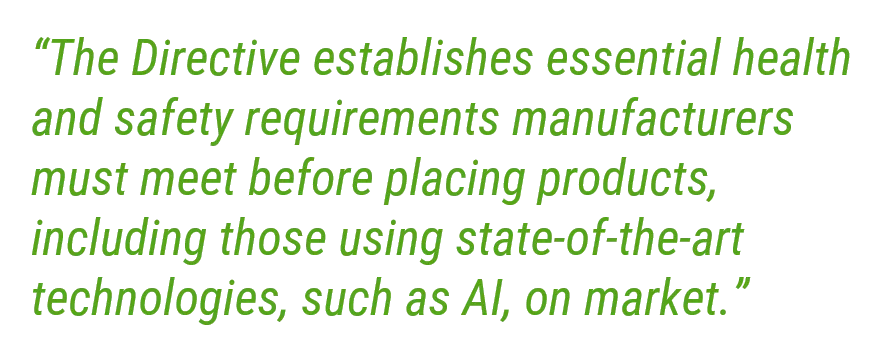
The European Union Machinery Directive aims to both ensure a high level of safety for machinery users and facilitate the free movement of machinery in the EU market. In recent years, the European Commission has reviewed the Directive with any eye toward improving safety levels further taking into account the latest IT innovations. The current proposed revision seeks to align the Directive with EU-harmonised legislation on product health and safety, and to address safety challenges arising from technical progress in digitization.
SEMI shared its views on the proposed revision of the Directive with the European Commission to reflect the interests of the electronics manufacturing industry.
1. AI technologies are already used in semiconductor manufacturing
 Using artificial intelligence (AI) tools, today’s semiconductor fabs combine equipment know-how and manufacturing statistics to manage massive fault detection data, increase manufacturing efficiency and improve yields. For instance, AI enables the real-time collection and monitoring of massive amounts of data, then alerts system administrators of any hardware failures or abnormalities. AI also makes it possible to automate manufacturing process adjustments and corrections by providing feedback that can drive higher processing efficiency.
Using artificial intelligence (AI) tools, today’s semiconductor fabs combine equipment know-how and manufacturing statistics to manage massive fault detection data, increase manufacturing efficiency and improve yields. For instance, AI enables the real-time collection and monitoring of massive amounts of data, then alerts system administrators of any hardware failures or abnormalities. AI also makes it possible to automate manufacturing process adjustments and corrections by providing feedback that can drive higher processing efficiency.
A secure cyber-physical space is critical to ensure safe use of industrial data, AI, and, by extension, fab equipment, making security a top priority for electronics manufacturers. However, the consensus view of SEMI members is that addressing these security concerns through any revision on the Machinery Directive would be difficult and problematic. The Directive establishes essential health and safety requirements manufacturers must meet before placing products, including those using state-of-the-art technologies, such as AI, on market. SEMI’s position is that the use of AI technologies and its impact on cybersecurity is better discussed and framed under relevant cybersecurity policies.

2. Customers increasingly demand digital documentation
Electronics manufacturing is shifting to eliminate the use of paper for technical and operational reasons. For instance, customers demand that documents accompanying products are in digital format, as paper is generally prohibited in clean rooms. Many businesses also use software tools, mainly using English as the common business language, that update customers on revisions to product manuals. These tools include training programs for operators on the use and maintenance of products. Adapting the Directive’s documentation requirements to allow digital formats in more languages would reduce administrative burden for the industry.
3. Alignment with the New Legislative Framework will be necessary
 While it has not been a serious concern for businesses, the Machinery Directive should align with the New Legislative Framework and adapt relevant documents such as declaration of conformity and technical files. For instance, SEMI members receive requests to include an Annex IIB for partly completed machinery, but the requests are unclear on when it is necessary to provide the Annex. When it comes enforcing the Directive, market surveillance authorities should be better coordinated, as many businesses report that enforcement varies from one Member State to another and in some cases is too lax, posing environmental, health and safety risks to users.
While it has not been a serious concern for businesses, the Machinery Directive should align with the New Legislative Framework and adapt relevant documents such as declaration of conformity and technical files. For instance, SEMI members receive requests to include an Annex IIB for partly completed machinery, but the requests are unclear on when it is necessary to provide the Annex. When it comes enforcing the Directive, market surveillance authorities should be better coordinated, as many businesses report that enforcement varies from one Member State to another and in some cases is too lax, posing environmental, health and safety risks to users.
4. Practical guidance would help clarify legal requirements for implementing the Machinery Directive
While some manufacturers report possible legal uncertainties surrounding the implementation of the Machinery Directive (e.g. partly completed machinery) and suspect inconsistencies and overlaps with other directives (e.g. with the Low Voltage Directive), many SEMI members do not see these as serious concerns and reasons to revise the Machinery Directive. Rather, SEMI members prefer specific guidance as to when to refer to the Machinery and e.g. Low Voltage Directives.
SEMI members’ common view is that the Machinery Directive is in general fit for the purpose, provides essential health and safety principles, and eases the circulation of machinery both in the EU and beyond. However, the improvements proposed here would benefit the industry, regulators and enforcement authorities.
Emir Demircan is senior manager of public policy at SEMI Europe. Contact Emir at edemircan@semi.org , 0032484903114.